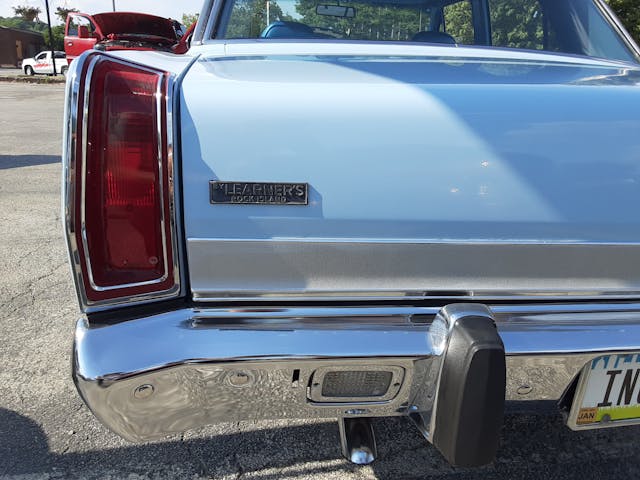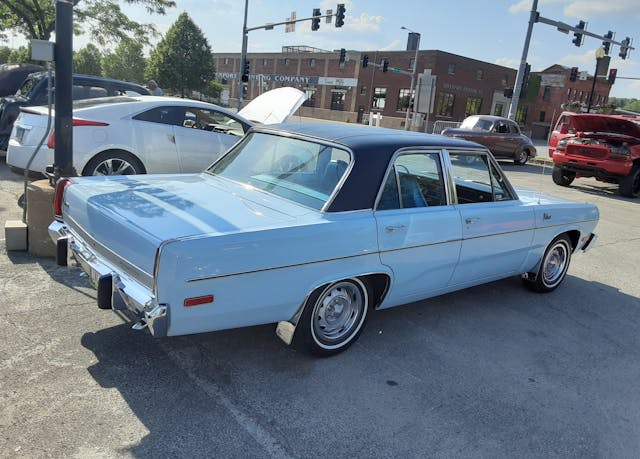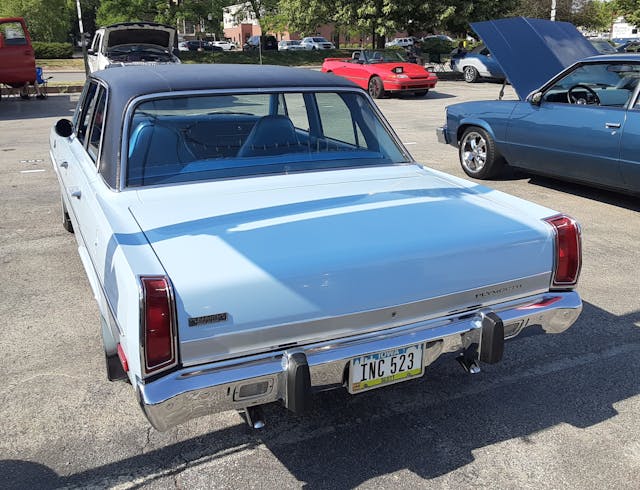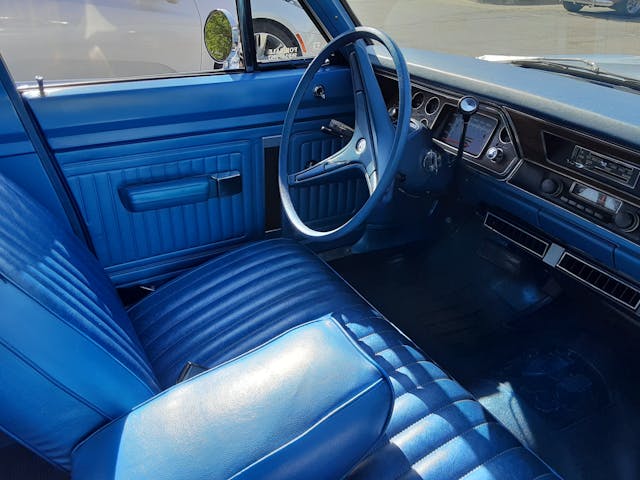1973 Plymouth Valiant: Blue Skying

The Valiant was first introduced in the great wave of compact American cars in 1960. Up until then, basically every American car was the same size, other than outliers such as Rambler and short-lived cars like the Henry J and Hudson Jet. Up until this point, only Rambler had really found a niche in the market; the others had long faded away as the ’60s dawned.

But that all changed in Autumn 1960 when the Valiant, along with the Ford Falcon and Chevy Corvair, appeared and unknowingly changed car lineups for good. While many buyers stuck with the standard-sized cars, newly dubbed “full size,” the compacts proved immediately popular.

While the Corvair faded away after 1969—due partly to a book by a certain lawyer and partly to the introduction of the utterly conventional Chevy II in 1962—and the Falcon survived through 1970 (fun fact: The ’70 Falcon was first sold as a near-identical version of the ’69, but partway through the model year became a “1970 1/2” Falcon, using the newly redesigned Torino midsize body), the Valiant carried on along swimmingly, along with its corporate sibling the Dodge Dart. And those A-body Mopars sold like dollar beer at a baseball game.

By 1973, the Valiant came in three basic versions: The sporty Duster coupe (which first appeared in 1970), the Scamp two-door hardtop (which shared its body shell with the Dodge Dart Swinger), and that favorite of librarians, school teachers, and grandparents near and far: the Valiant four-door sedan.

All 1973 Valiants got a new face to go along with their new 5-mph front bumpers that were federally mandated that year. Rubber-tipped bumper guards flanked the license plate and there was a new grille and power dome style front hood, all of which contributed to make the front end look much less flat than it did in 1972.

The 1973 Valiant sedans had a 108-inch wheelbase and overall length of 195.8 inches. As you’d expect for a 1970s Mopar product, the front suspension utilized torsion bars for better handling. Front disc brakes were standard on V-8 models and optional on Valiants equipped with the bulletproof Slant Six. A more robust 225-cubic-inch Slant Six was also optionally available.

Other options included air conditioning, electric clock, an AM/FM stereo radio, Rallye cluster (probably much more common on Duster 340s than Valiant four-doors), tinted glass, three-speed electric windshield wipers, and a trailer towing package.

The 1973 Valiant sedan had a base price of $2447 ($16,921 today) with the 198-cu-in Slant Six and $2564 ($17,730) with the 318-cu-in V-8; 61,826 four-doors were built for the model year.

But the Duster was the best-selling model by a wide margin, with 249,243 built in ’73. Scamp production totaled 53,792. Oh, and approximately 15,000 Duster 340s were sold on top of the regular Duster production figure.

One interesting thing about the 1973 sedan is it was the last one to use the original 1967 Valiant body shell. Starting in 1974, the four-doors would use the same body as their corporate sibling, the Dodge Dart—I’m not sure why, but possibly because the Valiant sedan body was pretty rectilinear and the Dart sedan body was “swoopier,” at least compared to the Valiant body.

Darts, Dusters, and Valiants would continue on with only minor changes through the 1976 model year, when production of both the Dart and the Valiant ended for good.

They were replaced with the F-body Plymouth Volaré and Dodge Aspen. And while they were very tidy and attractive, early versions had some teething issues, in particular rusting front fenders. But there was a cool wagon version, and by the late ’70s they were pretty robust, and they would morph into the Dodge Diplomat and Plymouth Gran Fury in the 1980s, becoming well-loved by police departments and taxi drivers across the land.

I spied this like-new Valiant back on May 31 at the weekly cruise-in on the Davenport riverfront. I had just taken the bridge from Illinois to Iowa, was sitting at a red light, and I immediately spotted a light blue Valiant-shaped object in the distance. I couldn’t wait for the red light to change. It was driving me insane.

So the light finally turned green, I rapidly parked, and I leapt from the car and basically ran over to this car. It was so cool! I still see Dusters and Dart Sports on a semi-regular basis (usually modified and not stock, but still …), but the four-door sedans, both Valiant and Dart, are pretty uncommon.

And this car was neat as a pin. The owner came up as I was frantically taking pictures and told me a little bit about it. He is the third owner, and the car was sold new at Learner’s Chrysler-Plymouth, which lasted in my hometown of Rock Island, Illinois, until 1998–99, when it was purchased by Dave and Dan Kehoe, moved to Moline, and became Courtesy Chrysler-Plymouth.

The owner and I chatted awhile, and he was very nice. He originally bought the car because his wife loved it, but he told me she has yet to ride in it and he was thinking about selling it, as he has nine other vintage cars. It was finished in appropriately-named Blue Sky paint and was loaded (by Valiant standards) with the 318 V-8, air conditioning, cruise control, the Rallye Road Wheels (which were available but rarely seen on Valiant sedans), and the split-back front bench seat with fold-down armrest.

I loved it and hope that if the current owner does eventually let it go, that it goes to a good home. And yes, I was reminded of the Valiant famously piloted in the TV movie Duel, even though this one was not orange and a few years newer.

***
Check out the Hagerty Media homepage so you don’t miss a single story, or better yet, bookmark it. To get our best stories delivered right to your inbox, subscribe to our newsletters.


The Dart 4-door had a 111 inch wheelbase versus the Valiant’s 108 inch. The move to the Dart body in 1974 was two-fold: added legroom in the back seat and parts commonality, especially with the 5-mph rear bumpers mandated in 1974 (they only needed to protect at 2 1/2-mph in 1973). Since the rear of the pre-74 Valiant was completely differ from the Dart, an entirely different rear bumper would need to engineered and tooled without the switch to a common body shell. Chrysler was already in a financial bind by 1974 and cost -cutting measures were employed in many areas.
Interesting aside: the hood on the 1974-1976 Dart was a carry-over, originally used on the 1969 Barracuda.
I come from a Valient rich family In 1958 our family moved from Detroit to Tarzana California. In Detroit, my mom’s side of the family all worked at Chrysler’s Highland Park headquarters and the entire family drove cars built by the Chrysler Corporation. In 1960, my dad bought the first Valient sold in Los Angeles County. It was white with red and black interior. It was a V200, with the 225 Slant Six, with a 3 speed manual transmission with a floor shifter. I was only 5 years old and already a Gearhead. Buying that Valient started a flood of Valients in our family and neighborhood. I was 16 in 1971, and in 1964 my dad bought a new white with red tuck and roll vinyl interior, it too was a V200 with the 225 Slant Six with a Tourqueflight automatic transmission with push button drive. I was sorry to see Chrysler did away with push button drive in 1965, the push button drive was a Chrysler hallmark that separated Chrysler from the rest of the global auto industry. The last Valient bought in our family was a 1968 dark green metallic paint with a light tan vinyl interior. I remember thinking it was such a downsized Chrysler, it was a great example of Chrysler Corporation’s heritage styling it fit right into Chrysler’s line up perfectly.
My Uncle owned one of these. He previously had owned a non powered brake version, but upgraded to the newer version with the power front disc braking system purchased after the old car was too worn out. Those power front disc brakes were somewhat shocking to him when he started using the new car on the infamous Chicago Lake Shore Drive(LSD). He was surprised by the deceleration performance going into and through the notorious LSD S-curve. That was decades before the posted speed limits on LSD were lowered. Usually you went through the S curve and exited with a sore braking leg at the exit if you were using a car with drum brakes or non-powered brakes. My Uncle rejoiced at having a usable pain free braking leg with the new car.
Some of my various cousins owned some full sized Imperials and other full sized Chrysler sedans and wagons and already had the better power disc brakes.
The “basically every American car was the same size until 1960″ line is interesting to me.
From a GM perspective, 115″ wheelbase was the sweet size (49 Chev sedan, 55 Bel Air, 64 Chevelle, 78 Monte Carlo, 88 Caprice, 96 Caprice all stuck between 115-116”). Front and rear overhang does change the perception of size sometimes (look at gen 1 Mustang platform for that…).
The “New Full size” GM cars of 1958-59 era rose up to 117.5-124″ wheelbase. Even the Impala grew through the 60s (119) to its 70’s peak in the 121″ range.
The point being that cars (at least GM) jumped 4-9″ in 58-59 as the new models came out. GM backtracked pretty fast with the 60’s midsize car basically being equal to your 55 Chevy and that spec held strong late into the 1990s.
I think many of us yearn for 115″ wheelbase new car from… anyone… that is a mass-market price. I’m sure some would go for a 124″ with big overhangs too. 2023 Toyota Crown is a hair over 112″, so I guess that’s the option?
I think he meant that, at each point, the major marques were similarly sized-and big was the size. After 1960, all bets were off.
That’s a fair interpretation.
I still remember when these were sub-par clunkers people bought for basic transportation. A buddy of mine had one that would diesel for a minute or two after he shut it off. I used to joke that it ran so good it didn’t want to stop. He sold it to another buddy of mine and we took it to my house to look it over. The carb bolts were so loose I could move it side to side. I tightened them down (without changing the gasket) and it ran like a champ
I’ve owned six A-bodies so far, ranging from clunker to keeper (I still own the 69 Barracuda convertible), plus working on many more. The most clunker-ish was a $100 68 Barracuda coupe. It had somewhere way over 100K on the 225 slant six. It burned oil like crazy but was the only car in the family to start when we got a freak cold spell of -26F. I think that’s because the compression was so low the engine was still easy to spin in the frigid temperature! Nothing could kill the car. While the floors were solid after 15 years on Midwest salted streets, the right side torsion bar mount let loose. We welded it back together and I drove it another year. I sold it to a friend who drove it another couple years until the gas tank rusted through and he decided that it was time to give up. He drove it to the junkyard, after stripping some useable parts (I still have all the parts from the factory a/c, and the dash facia adorns my 69 convertible.
As I said, you couldn’t kill that car.
The car pictured is the exact copy of one I ordered but ended up cancelling back in 1973. Rallye wheels, factory A/C, color, everything I ordered is on this car!
Cruise Control was only offered in the 1975 model A Bodies, this looks to be an add on unit.
Looks like a Sears control unit, of which I have had a few.
Not the most interesting car to me but the color inside and out is very nice.
Nice colours, and refreshing to see one with the 318, and the rather deluxe interior. Still, an essentially boring car, in my opinion.
My brother-in-law ordered a new 1975, and drove it about 7 years, thru med school and residency. It was a L6 and 3-on-the-tree (with non-synchro first), but had an AM-FM radio, which played his kind of music (mostly easy-listening).
The LAST long lasting Chrysler vehicle until the early 21st century! When I was in Elementary school, My carpool driver purchased a Volare wagon ( M bodies were introduced to replace Valiant/ Dart) and within three years the car was disintegrating around the owners! The Plastic was almost dissolving,the cardboard roof liner was warping and the window trim was popping out! I don’t remember if they got the slant six or a 318 ( I’m not sure if the slant six was still in production in78′) all I remember is the rust bubbles!
Could you please email me on how I might contact the owner of this car. I read he may be interested in selling it and I’d give the car a pampered new home.